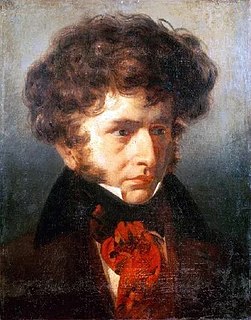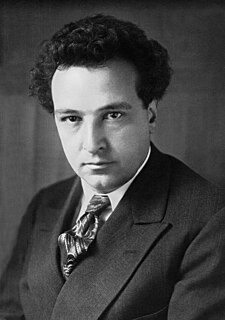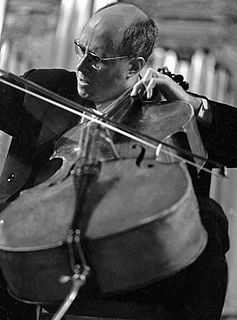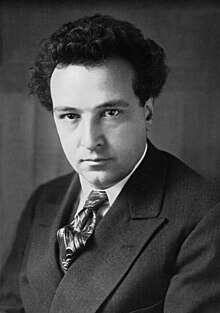
The Symphony No. 6 in A minor by Gustav Mahler is a symphony in four movements, composed in 1903 and 1904, with revisions from 1906. It is sometimes nicknamed the Tragic ("Tragische"), though the origin of the name is unclear.

Charles Munch was an Alsacian French symphonic conductor and violinist. Noted for his mastery of the French orchestral repertoire, he was best known as music director of the Boston Symphony Orchestra.
The Cello Concerto No. 1 in E-flat major, Op. 107, was composed in 1959 by Dmitri Shostakovich. Shostakovich wrote the work for his friend Mstislav Rostropovich, who committed it to memory in four days and gave the premiere on October 4, 1959, with Yevgeny Mravinsky conducting the Leningrad Philharmonic Orchestra in the Large Hall of the Leningrad Conservatory. The first recording was made in two days following the premiere by Rostropovich and the Moscow Philharmonic, under the baton of Aleksandr Gauk.

Felix Mendelssohn's Violin Concerto in E minor, Op. 64, is his last large orchestral work. It holds an important place in the violin repertoire and is one of the most popular and most frequently performed violin concertos in history. A typical performance lasts just under half an hour.

Harold en Italie,Symphonie en quatre parties avec un alto principal, Op. 16, H. 68, a symphony with solo viola by Hector Berlioz, written in 1834.

Francesca da Rimini: Symphonic Fantasy after Dante, Op. 32, is a symphonic poem by Pyotr Ilyich Tchaikovsky.

Anton Bruckner’s Symphony No. 2 in C minor, sometimes known as the "Symphony of Pauses", was completed in 1872. It was actually the fourth symphony composed by Bruckner, after the Symphony in F minor (1863), the Symphony No. 1 in C minor (1866), and the Symphony in D minor (1869).
Symphony No. 4, Op. 29, FS 76, also known as "The Inextinguishable", was completed by Danish composer Carl Nielsen in 1916. Composed against the backdrop of the First World War, this symphony is among the most dramatic that Nielsen wrote, featuring a "battle" between two sets of timpani.

Igor Borisovitch Markevitch was an avant-garde Russian composer and eminent conductor of Ukrainian origin who studied and worked in Paris and became a naturalized Italian and French citizen in 1947 and 1982 respectively. He was commissioned in 1929 for a piano concerto by impresario Serge Diaghilev of the Ballet Russe de Monte Carlo.

Michel Tabachnik is a Swiss conductor and composer.
Grzegorz Nowak is a Polish conductor. He has served as music director of the Polish National Opera, the Edmonton Symphony Orchestra, the SWR Radio Orchestra in Kaiserslautern, Germany), and Sinfonia Helvetica and festival Musique and Amitié in Switzerland. He is the Principal Associate Conductor of the Royal Philharmonic Orchestra in London.
The Symphony No. 3 by Robert Simpson was written in 1962 and dedicated to veteran composer Havergal Brian. The premiere was given by the City of Birmingham Symphony Orchestra on 14 March 1963 under the conductor Hugo Rignold. Its BBC Proms premiere was given by the Royal Philharmonic Orchestra on 21 August 1967 under the conductor Charles Groves. The US premiere was given by the Oklahoma City Symphony Orchestra on 8 December 1974 under its then Music Director, Ainslee Cox.

Symphonie Liturgique is the Third Symphony by the Swiss composer Arthur Honegger.

The Symphony No. 2 for strings and trumpet by Arthur Honegger was commissioned in 1937 by Paul Sacher to mark the tenth anniversary of the chamber orchestra Basler Kammerorchester. Progress was slow, however, in part due to the interruption of the Second World War. The music is primarily for strings alone and is very turbulent and troubled until the trumpet soloist enters near the end of the music, giving this mostly tragic work a hopeful ending.
The Symphony No. 3 in C major of the Swedish composer Franz Berwald, nicknamed the Singulière, was written in 1845. It is scored for 2 flutes, 2 oboes, 2 clarinets, 2 bassoons, 4 horns, 2 trumpets, 3 trombones, timpani and strings. It is about a half-hour in length and is in three movements:
- Allegro fuocoso in C major
- Adagio - Scherzo - Adagio
- Finale: Presto in C minor

The Symphony No. 1 by Swiss composer Arthur Honegger is a work for orchestra, written between December 1929 and May 1930 for the fiftieth anniversary of the Boston Symphony Orchestra. Its first performance was given in Boston on February 13, 1931, under Serge Koussevitzky.

The Symphony No. 4 by Swiss composer Arthur Honegger is a work for orchestra, written in 1946 on a commission from Paul Sacher. Subtitled Deliciæ Basilienses, it was first performed on 21 January 1947, by the chamber orchestra Basler Kammerorchester under Sacher. On the same program were the premieres of two other works commissioned by Sacher: Igor Stravinsky's Concerto in D and Bohuslav Martinů's Toccata e due Canzoni.
The Symphony No. 6, H. 343, by Bohuslav Martinů was begun in New York City in 1951, after a hiatus of four years since its predecessor, and was tentatively completed three years later on 23 April 1953. In Paris, in the months following its completion, Martinů undertook some revisions to the score. It is dedicated to Charles Munch, on the occasion of the 75th anniversary of the Boston Symphony Orchestra, who premiered the symphony on 7 January 1955. Martinů originally called the work Fantaisies symphoniques, and this is sometimes regarded as its only correct title.

Tout un monde lointain... is a concertante work for cello and orchestra composed by Henri Dutilleux between 1967 and 1970 for Mstislav Rostropovich. It is considered one of the most important 20th-century additions to the cello repertoire and several major cellists have recorded it. Despite the fact that the score does not state that it is a cello concerto, Tout un monde lointain... has always been considered as such.
Yvonne Gouverné, née Yvonne Marcelle Gouverné, was a 20th-century French pianist by training, who went on to become an accompanist and choir conductor.










